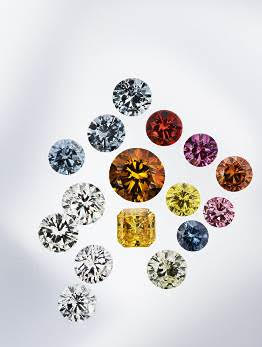Articles and News
Industry News: AmazonSmile Adds JFC As Beneficiary; Synthetic Diamonds In G&G; Zimbabwe’s Next Steps November 21, 2017 (0 comments)

Amazon Smile Adds Jewelers For Children As A Recipient Charity
New York, NY—Amazon shoppers now can donate to Jewelers For Children while shopping on the site. AmazonSmile is a simple and automatic way for shoppers to support their favorite charitable organization every time they shop—at no cost. The AmazonSmile Foundation gives 0.5% of all purchases to the chosen charity with every eligible purchase. To direct your purchase donations to go to Jewelers For Children, simply log onto smile.amazon.com, and under “Your Account,” choose “change your charity” and select Jewelers For Children as your charity.
All shopper account information on Amazon remains the same when logged into Smile.
However, Smile purchases must be made using an Internet browser. At present, purchases made from the Amazon app, Echo, Kindle, Dash, or Fire TV are not eligible for Smile.
Enter www.smile.amazon.com on your desktop or laptop, or to shop from a tablet or mobile phone, use the device’s Internet browser, rather than the Amazon app. Click here and here for more information.
Fall 2017 Gems & Gemology Features Colored Gemstones and Synthetic Diamonds
Carlsbad, CA—The fall issue of Gems & Gemology (G&G), the quarterly professional journal of GIA (Gemological Institute of America), includes a comprehensive summary of HPHT-grown synthetic diamond research.
The six articles featured in this issue also include historical saltwater pearls from the New World, the photoluminescence (PL) spectra of emeralds, synthetic star corundum, and the Colombian emerald industry from mine to market.
The issue opens with “Observations on HPHT-Grown Synthetic Diamonds: A Review,” the first comprehensive summary published on a large sample of several thousand HPHT synthetic diamonds, all of which were examined by GIA from 2007 through 2016. GIA researchers Drs. Sally Eaton-Magaña, James Shigley and Christopher M. Breeding investigate trends in the distinctive features seen among HPHT synthetic diamonds from multiple sources over the past ten years.
In “Saltwater Pearls from the Pre- to Early Columbian Era: A Gemological and Radiocarbon Dating Study,” researchers at GIA and the Gübelin Gem Lab examine 85 natural saltwater pearls reportedly recovered from Caribbean waters to determine their origin and 14C isotope radiocarbon dating. The research team, led by GIA’s Chunhui Zhou, confirmed that the pearls originate from a Pinctada species.
The next article is “Photoluminescence Spectra of Emeralds from Colombia, Afghanistan, and Zambia.” Researchers led by Dr. D. Brian Thompson of the University of North Alabama investigated the PL spectra of 48 samples from these regions. Their research strongly indicates that variations in trace element concentration within emeralds from these localities correlate with their PL spectra, which could be very promising for determining the geographic source.
The fourth article, by Dr. Karl Schmetzer, Prof. H. Albert Gilg and Dr. Heinz-Jürgen Bernhardt, is “Synthetic Star Sapphires and Rubies Produced by Wiede’s Carbidwerk, Freyung, Germany.” These stones were grown using a variation of the Verneuil method followed by controlled annealing that exsolved the rutile needles, giving these cabochons a distinctive appearance.
“True Colors of ‘Dalmatian Jasper’” explores the details of this popular gemstone whose unique spots are similar to the coat of a Dalmatian. Tomasz Powolny and Dr. Magdalena Dumańska-Słowik determine that this stone’s composition and gemological characteristics do not meet the definition of jasper. Their recommended term is “Dalmatian stone.”
The last article, “The Colombian Emerald Industry: Winds of Change,” explores the history, geology and ongoing transformation of the Colombian emerald market. Darwin Fortaleché, chief gemologist at Colombia’s CDTEC lab, and his GIA coauthors provided this comprehensive field report.
G&G’s Lab Notes section features an entry on the separation of synthetic melee from natural diamond using GIA’s iD100 screening device. The Micro-World section includes hematite roses and a “flower-in-the-rain” inclusion within a Sri Lankan sapphire, while the Gem News International section spotlights blue-green pyrope-spessartine with high vanadium content and two potential new sources of Nigerian sapphire.
This and every issue of G&G since 1934, including full articles, photo galleries and exclusive video footage, are available at no cost on GIA’s website here. Additional research articles are available at http://www.gia.edu/gia-news-research. Print subscriptions and copies of back issues are available at http://store.gia.edu, or by contacting G&G customer service at +1 760-603-4502.

The HPHT synthetic diamonds on the cover of Gems & Gemology, part of the GIA collection and ranging in weight from 0.31 to 1.94 ct, demonstrate the colors and sizes now seen in this lab-grown material. Photo by Kevin Schumacher/GIA.
As Mugabe Resigns, What Becomes Of Zimbabwe’s Diamonds?
Harare, Zimbabwe—After 37 years of rule—during which human rights abuses forced an embargo on some of the country’s diamond exports—Zimbabwean president Robert Mugabe resigned on Tuesday, sparking national celebrations in the streets. The 93-year-old leader had been placed on house arrest by the country’s military, as its parliament began impeachment proceedings.

Robert Mugabe. Image: CNN.com
Mugabe had been the nation’s leader since its independence from Britain in 1980. He ruled with an iron fist, which among other atrocities led to a ban on diamonds from the nation’s rich Marange fields in the eastern part of the country in 2009.
Although Zimbabwe had signed on to the Kimberley Process in 2003, the document was very specific in its definition of conflict diamonds: those being used by rebel groups to fund wars or coups d’etat against a legitimate government. It didn’t include diamonds ill begotten as the result of abusive, albeit legitimate, governments. In Zimbabwe’s Marange fields, it was state security agencies who were killing and beating miners and using forced labor to get diamonds.

Artisanal miners in the Marange fields. Image: Rubel & Menasche
The international diamond community responded with a two-year ban on stones from the Marange region, which was lifted in 2011 after the country promised to address areas of noncompliance. But even as recently as last year, many questions remained about the transparency of the Zimbabwean diamond industry, especially as the government owns at least a 50% stake in it.
The Centurion will follow developments of this issue as they unfold.







